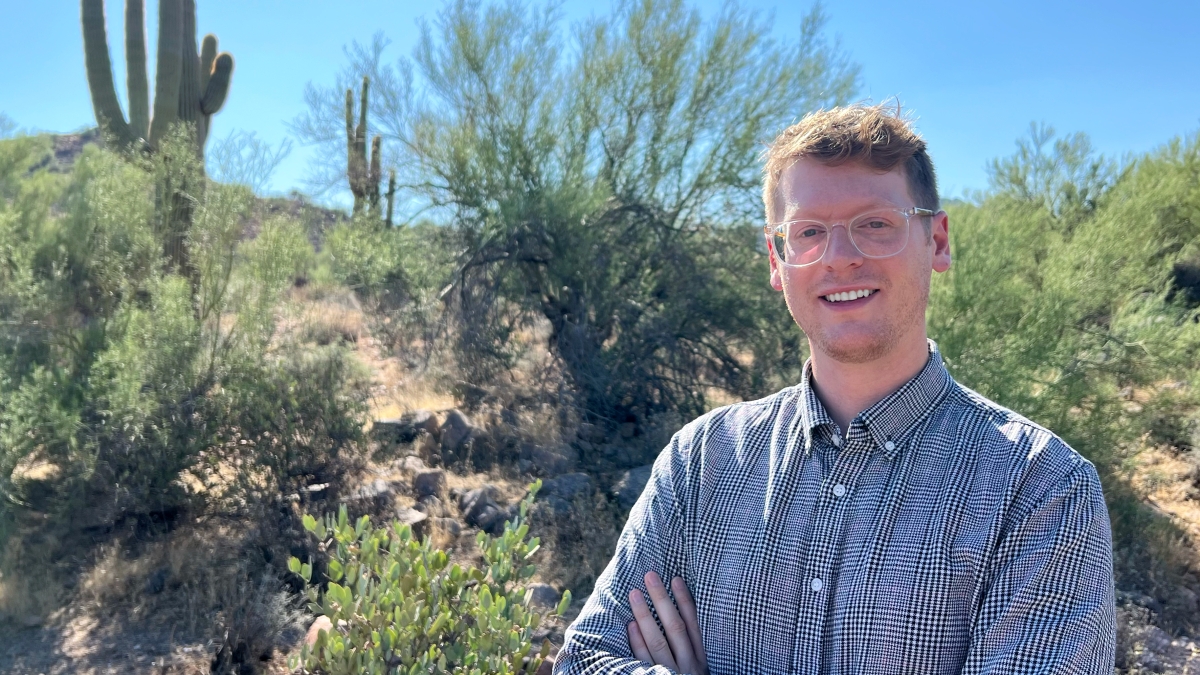The quantum revolution: Changing how we understand our world

Justin Earley joined the School of Molecular Sciences at ASU this semester as an assistant professor. ASU photo
How far can we push scientific measurement into the quantum realm?
For Justin Earley, the answer to this lies within molecular qubits (i.e., quantum bits), and his research at Arizona State University aims to transform how we understand our world.
Earley joined the School of Molecular Sciences at ASU this semester as an assistant professor, bringing with him a research interest in quantum information chemistry and spectroscopy, with an emphasis on quantum sensing.
Quantum sensing is difficult for people to understand. Earley likes to use a simple analogy: “What we’re doing with qubits is like when you wet your finger and run it around the rim of a wine glass to make it ring. If you add more water to the glass, it alters the pitch and clarity of the ringing. Qubits, then, are like highly sensitive wine glasses, and we ‘listen’ for changes in their pitch and clarity. How they change helps us understand what they’re sensing.”
Answering the fundamental questions of “why” and “how” these molecular qubits behave will help accelerate the future of quantum information sciences, and has the potential to impact multiple industries, from medicine to renewable energy.
Earley says that his approach to chemistry is centered around developing and improving instrumentation, enabling new and exciting insights into complex molecular problems.
One area he’s focusing on is developing instrumentation to study and interact with qubits. He wants to understand what makes an effective molecular qubit by linking their chemical properties to their qubit efficiencies. Additionally, he’s investigating how molecular qubits behave in different environments, such as inside cells or in more complex assemblies, with the aim of going beyond the classical limits of detection and into the quantum realm.
Besides understanding molecular qubits, Earley’s research explores two avenues for applying molecular qubits for quantum sensing.
First, one can imagine assembling molecular qubits into a quantum sensing layer. Then, for example, one could place a thin slice of a biological sample, like a biopsy, onto a layer of qubits and use it to image the sample at the quantum level. The U.S. Department of Energy, for instance, is very interested in using qubits to detect hydrogen flow in green hydrogen production and use. “Hydrogen is incredibly hard to detect, and if we can develop a robust sensor that doesn’t need constant replacement, it could greatly advance green hydrogen initiatives,” Earley says.
The second approach is more of an "in situ measurement" using qubits to detect pressure, temperature, and electric field or magnetic field changes at the quantum level from within the sample — for example, docking a qubit into an enzyme or a protein to study its functions in real time, or incorporating molecular qubits as quantum sensors into electronics to monitor sensitive components within the circuit.
"In a world where 'one size fits all' rarely applies," Earley says, "I believe molecular qubits will play a key role in translating quantum technologies beyond the lab and into real-world applications."
Earley received his bachelor's degree in chemistry from the University of Wisconsin–Madison, followed by a PhD in physical chemistry from the University of Colorado Boulder in partnership with the National Renewable Energy Laboratory.
He focused on spectroscopic developments to tackle new molecular problems in the areas of optical spectroscopies and cavity-enhanced microwave spectroscopy. This innovative spirit carried into his postdoctoral work in the College of Engineering and Applied Science at the University of Colorado Boulder, where he focused on the development and detection of mid/long-wave infrared dual-comb spectroscopy.
“I’m particularly drawn to the potential of molecular qubits because of their versatility,” he says. "Since they are molecules, their designs can be engineered for specific and innovative applications, whether that’s for sensing in biological systems for human health, detecting hydrogen in green energy solutions or assembled in an array for computing applications.”
More University news

Miki Kittilson appointed dean of ASU's College of Global Futures
Miki Kittilson has been appointed dean of Arizona State University’s College of Global Futures, a unit of the Julie Ann Wrigley Global Futures Laboratory.“As we enter this next phase of…
Graduate College celebrates 2024–25 Outstanding Faculty Mentors
Each year, Arizona State University’s Graduate College celebrates faculty members who have demonstrated an unwavering commitment to mentoring and supporting graduate students and postdoctoral…

ASU's building boom illustrates university's commitment to keep moving forward
To understand how Arizona State University is never settling and constantly improving, look up.At the seven-story student housing complex being built near Mill Avenue in Tempe.At the…